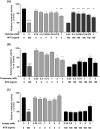Development of a self-limiting model of methotrexate-induced mucositis reinforces butyrate as a potential therapy
- PMID: 34824316
- PMCID: PMC8617074
- DOI: 10.1038/s41598-021-02308-w
Development of a self-limiting model of methotrexate-induced mucositis reinforces butyrate as a potential therapy
Abstract
Gastrointestinal mucositis is a complication of anticancer treatment, with few validated in vitro systems suitable to study the complex mechanisms of mucosal injury. Therefore, we aimed to develop and characterize a chemotherapeutic-induced model of mucositis using 3D intestinal organoids. Organoids derived from mouse ileum were grown for 7 days and incubated with different concentrations of the chemotherapeutic agent methotrexate (MTX). Metabolic activity, citrulline levels and cytokine/chemokine production were measured to determine the optimal dosage and incubation time. The protective effects of folinic acid on the toxicity of MTX were investigated by pre-treating organoids with (0.0005-50 µg/mL) folinic acid. The impact of microbial-derived short-chain fatty acids was evaluated by supplementation with butyrate in the organoid model. MTX caused a dose-dependent reduction in cell metabolic activity and citrulline production that was salvaged by folinic acid treatment. Overall, MTX causes significant organoid damage, which can be reversed upon removal of MTX. The protective effect of folinic acid suggest that the organoids respond in a clinical relevant manner. By using the model for intervention, it was found that prophylactic treatment with butyrate might be a valuable strategy for prophylactic mucositis prevention.
© 2021. The Author(s).
Conflict of interest statement
The authors declare no competing interests.
Figures






References
Publication types
MeSH terms
Substances
Grants and funding
LinkOut - more resources
Full Text Sources

